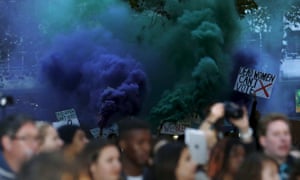Feminist protesters storm red carpet at London premiere of Suffragette'- The Guardian, 07/10/15
http://www.theguardian.com/world/2015/oct/07/feminist-protesters-storm-red-carpet-at-london-premiere-of-suffragette
The article has a bold headline to attract the reader's attention and inform them of an event in a concise way that is informative but doesn't go into too much detail so the reader knows enough to be interested in the article. The subtitle 'Feminist protesters storm red carpet at London premiere of Suffragette
' intrigues the reader particularly by the lexical choice of storm. The imagery of fast-paced, unstoppable action has connotations of a force of
nature: something that is inevitable and can't be controlled. It also makes the reader think of a
large mass of people because of the collective noun of protesters all going in the same direction with the same objective in mind.
As well as this, the contrast of protesters, who are normally considered to be more present in
informal settling such as city streets, being on the red carpet suggests
prestige, formality which entices the reader into reading more. There's also the stereotype of protesters being from working class
backgrounds and being somewhere 'unobtainable' to stardom that is entertaining for the reader.
There is also a faded subtitle smaller than the headline which gives the reader more information about the event and encourage them to read the rest of the article: 'More than a hundred protesters jumped the barriers onto the red carpet
as green and purple smoke bombs filled the air outside the Odeon cinema'
. The quotation
'more than a hundred' is quite ambigious because more than a
hundred could be 105 or 175 and this could exaggerate the amount of
feminists protesting and therefore increases the impact of the article on the reader.
The lexical choice of 'jumped' suggests connotations of high energy,
youth, revolution, for example jumping over metaphorical barriers being protesters jumping over barriers at a
prestigious event.
By specifying that the smoke was green and purple has a dramatic effect on the reader, showing it's importance and informing the reader on how visually effective the smoke was.
The imagery of smoke having 'filled the air' suggests not being able to get away from the smoke in the same way protesters on the red carpet were unavoidable, shown in the quote: 'Presenter Lauren
Laverne was forced to raise her voice to interview the
directors on camera in front of the cinema as the activists chanted...' The focus of the article is also slightly ironic because it is giving a voice to the protesters who were trying to be silenced at the event. This is a unique angle to the story because most other newspapers would have only interviewed the actresses on the red carpet and their opinion on the situation and not spoken to the protesters, but the Guardian gives a voice to both the actresses and the feminist protesters which could be refreshing and more interesting for the reader.
The article is presented in short paragraphs which could be because
as the article is online, the journalist has awareness that the reader
does not have a lot of time to read long walls of text. The article is
broken down so that it could be skim-read during someone's lunch break,
on the tube on someone's phone etc and this means the article is accessable for anyone who can get onto their website. However, the article also caters for people with more time on their hands as key phrases such as 'Suffragette' and 'Sisters Uncut' have links to other
articles on The Guardian website that are relevant to the article being
read so that extra information is available if the reader wants to learn
more without weighing down the article with extra unnecessary details.
There are also 4 photographs from the premiere featured in the article that attract
the reader's attention because of their colour and eyecatching signs:

This keeps the reader entertained and interested as well as further breaking down the
text. A caption underneath each picture briefly describes what's
happening in the picture so even if readers hadn't read the article, they could gain a good visual understanding of the event just by looking at the picture.
Direct speech from the objects of the
article also makes the article feel more informal and entertaining andthe space for comments at the bottom of the article
makes the reader feel involved in the article and it's topic, which could cause them to form their own opinions and get involved in the 'conversation'.
